LA Galaxy is a staple name of Major League Soccer, a team with a history of success, and a raft of world-class names that wore the infamous white jersey in recent years. In no particular order, Premier League legend Steven Gerrard, ex-Chelsea and England full-back Ashley Cole, Zlatan Ibrahimović and of course who could forget ex-Manchester United and Real Madrid winger, David Beckham. Now, as it stands after just 17 games, this great MLS side finds themselves in an unfamiliar position, bottom (12th) of the Western Conference.
Guillermo Barros Schelotto’s side has picked up only 10 points from their last 10 games (3W-1D-6L), scoring only 12 and conceding 21 in that time. Needless to say, the Galaxy needs to stop the bleeding and work on turning spirited performances into points if they want to make the playoffs.
Following a careful review of the Galaxy’s first 17 MLS games, with the support of key data this tactical analysis looks at five crucial aspects they need to address in and out of possession if they are to turn their season around.
1. Ineffective pressing strategy
The first aspect of LA Galaxy‘s game we highlight is their inefficient pressing strategy. During the opposition build-up phase, the Galaxy generally morphs into a 4-4-2 mid-block such that may be a little more compact and not vertically stretched by a high-press. However, for the mid-block to be successful, there has to be a strategy to dictate the opponent’s attack, set traps to isolate the ball carrier and engage the press.
When the first line of defence fails to dictate and nullify the attack, passes and dribbling options into midfield are more easily discovered through quick lateral balls across the back four. As the Galaxy only have four players occupying the middle third, it is difficult for these players to be compact on one side then quickly shift across the field to defend an attack on the other. Often this is where we see the opposition build-up get in behind the midfield and enter the final third with less pressure.
Let’s take a look at one example of LA Galaxy’s ineffective pressing from the front and subsequently in midfield, taken from the recent clash against San Jose. The Galaxy lost this game 0-4 and partially due to this type of passive defending.
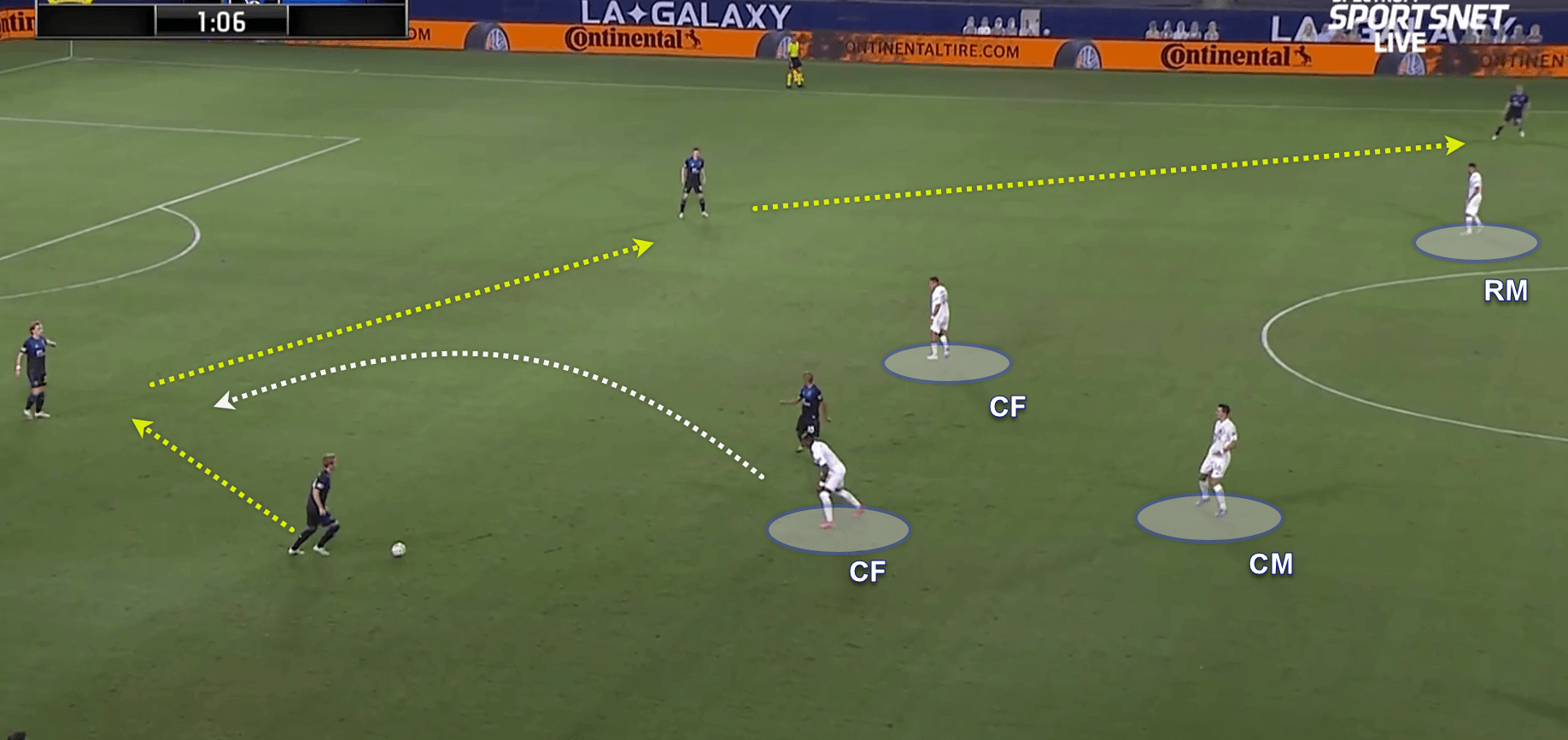
San Jose build from the back with deep lateral passes in the beginning. The front two for LA Galaxy are Yony González (left) and Javier Hernández (right). As the play reaches the Galaxy’s left flank, this would have been an ideal opportunity for the front two to isolate the San Jose midfielder in possession and engage the press.
Had both ‘CFs’ taken a higher line and pressed from the same side of the ball carrier’s options, this would have forced the San Jose player into forcing a pass into a numerically inferior midfield or better yet, force a mistake. Subsequently, San Jose play back across and get the ball into the middle third with ease.
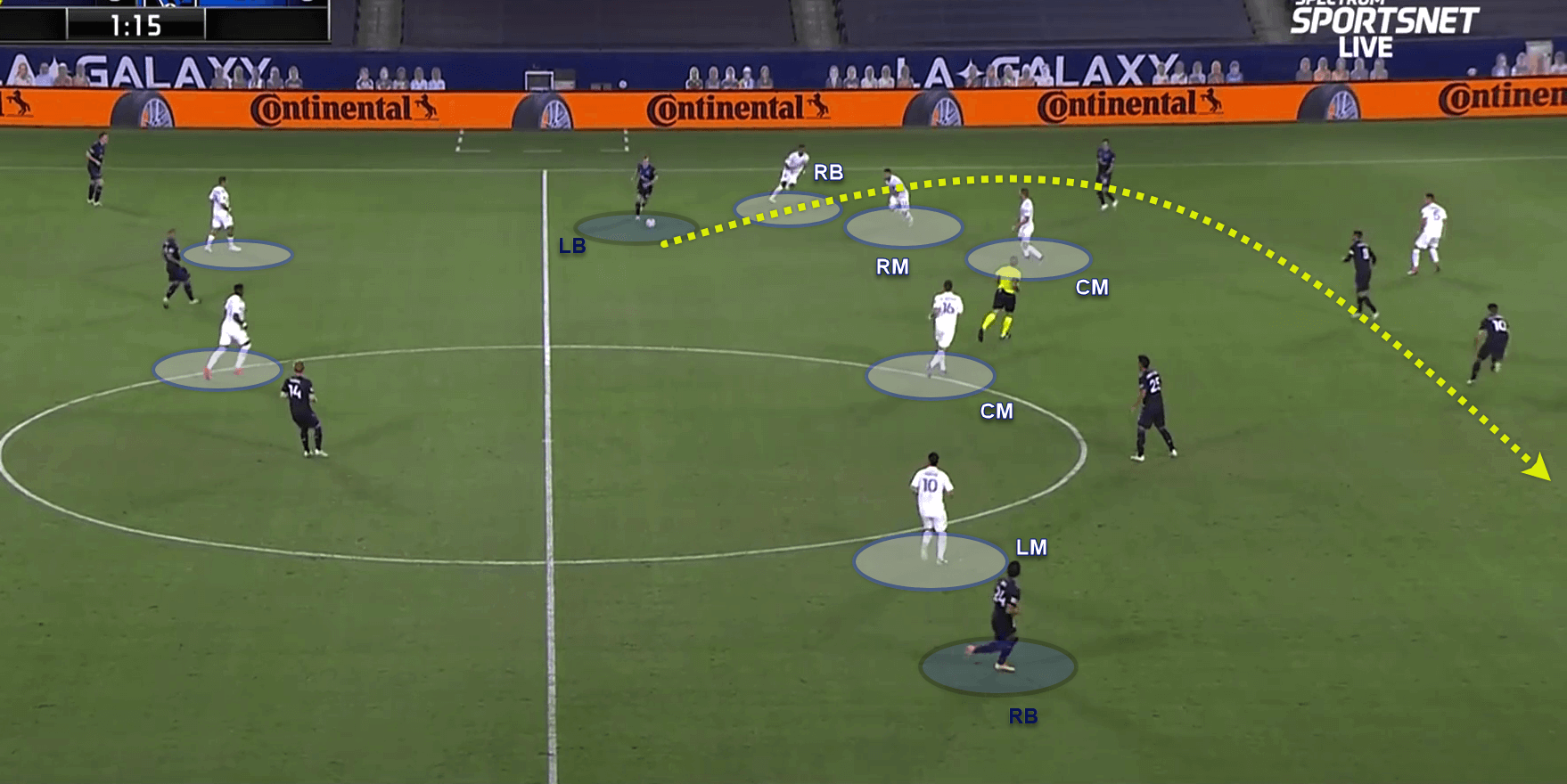
From here the San Jose left-back Tommy Thompson receives and dribbles infield with virtually no pressure before playing a long diagonal pass into the run of the advancing right-back Nick Lima. As Thompson received the initial pass, there was ample time and opportunity for either if not both of the Galaxy’s wide players Sebastien Lletget or Julian Araujo to engage the press and kill the attack.
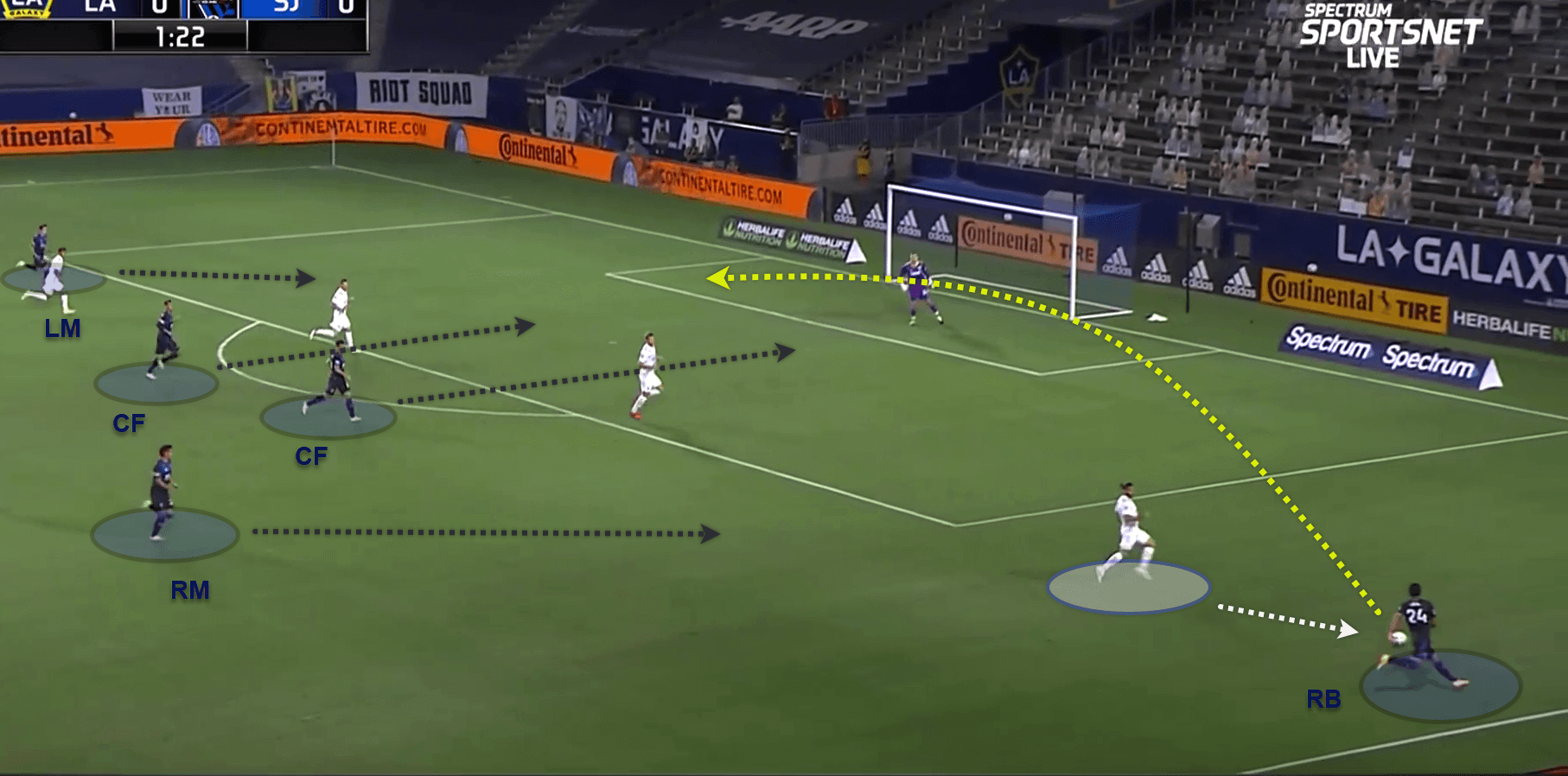
As the play reaches the advancing right-back, Lima, the Galaxy back four are stretched and very vulnerable from this position. Left-back Emiliano Insúa steps out to engage the ball carrier, yet, he could have done so more effectively by closing the distance between them in the moments previous, as from here Lima can still pass back or cross. As both of San Jose’s forwards are sprinting to the penalty area, observe the danger created by the supporting ‘RM’ for San Jose as he is in a good position to receive a pass, drive into the penalty area or have a shot. On this occasion, San Jose opted for a cross, and the attempt on goal was unsuccessful.
This 2020 MLS season, La Galaxy have an average PPDA (Allowed Passes Per Defensive Action) of 11.86. Meaning, on average, the Galaxy allow their opponents 12 passes before engaging in a defensive action such as a tackle or interception. I should preface; this metric is not a piece of data that alone tells a story; however, it is a proxy to help us understand a team’s defensive intensity, among other factors.
Although the Galaxy rank 16th highest of all MLS teams in this statistic, it is still a staggeringly high number for a team that wishes to be competitive and impose themselves in the league. Upon reviewing La Galaxy’s first 17 MLS games this season, I notice teams are getting a lot of success and secondary success such as corners, throw-ins and free-kicks in dangerous areas as a result of their ineffective pressing strategy.
2. Low intensity defending
Here is one staggering statistic: LA Galaxy currently rank 22nd among 26 MLS teams for challenge intensity, first being highest intensity, last representing lowest intensity. A rating of 5.4 means the Galaxy only engage with a defensive action such as a tackle, interception or loose ball duel five times for every one minute the opponent has possession.
When reflecting on goals the Galaxy have conceded this season from open play, we very rarely wind the tape back just a few more moments or passes up the field, rather just reflecting on the last duel and finish on goal.
If you did, many times you would find a Galaxy player, standing off the opponent, not pressing the ball-carrier at the best time, If even at all. Also, Galaxy players offer opponents their desired pass or crossing angle, as well as time and space to dribble into the box.
Let’s take a look at an example of how the Galaxy got punished from passive defending in their third, taken from the recent game against the Portland Timbers, a game they lost 3-6.
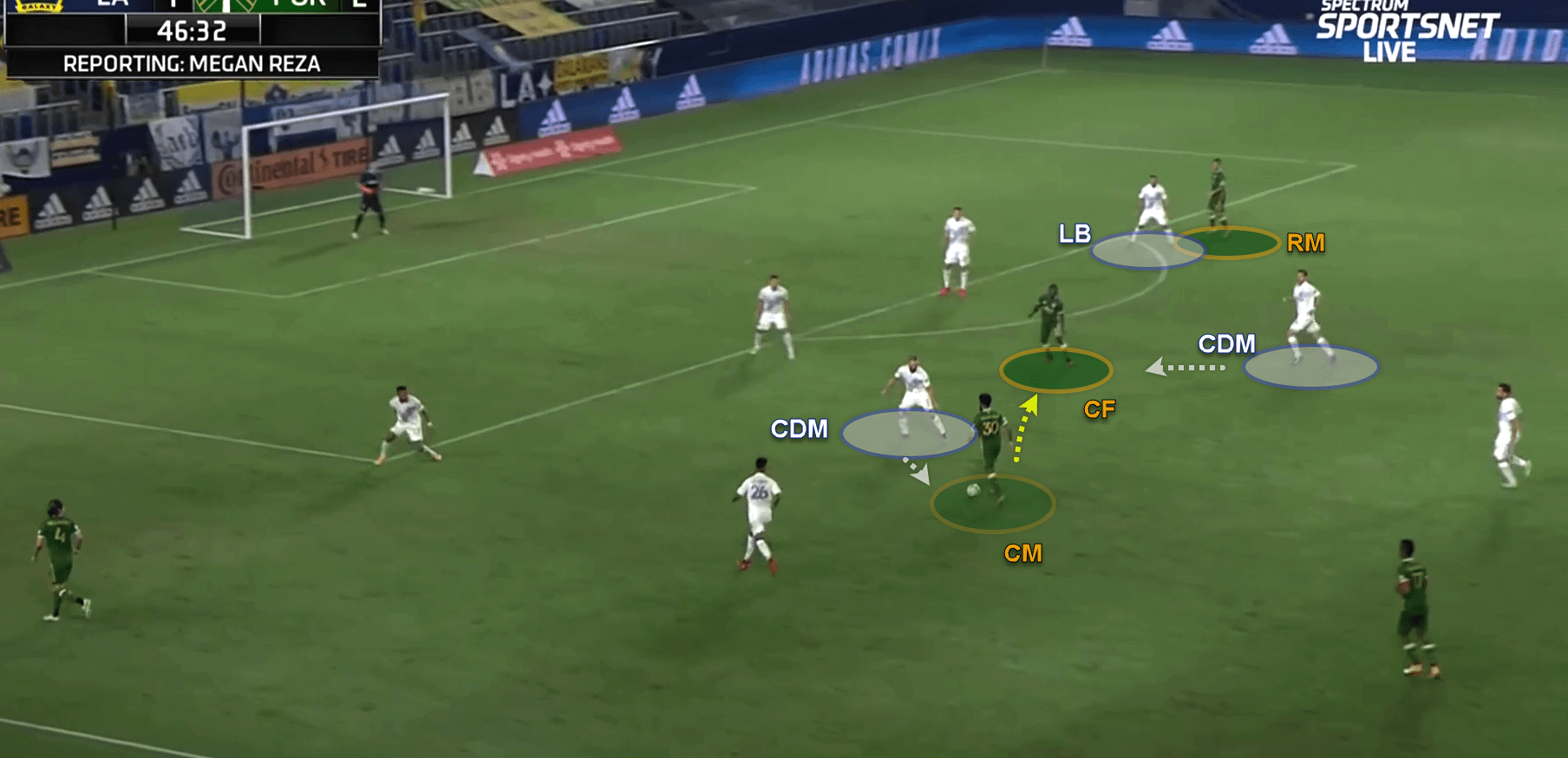
The Portland’ CM’ is dribbling at the Galaxy’s ‘CDM’ ; note this and moments prior would be a good opportunity for the ‘CDM’ Perry Kitchen to engage the press. A pass is made to Portland’s ‘CF’ who turns with ease, note, again the ‘CDM’ Sacha Klještan could have marked the player much earlier
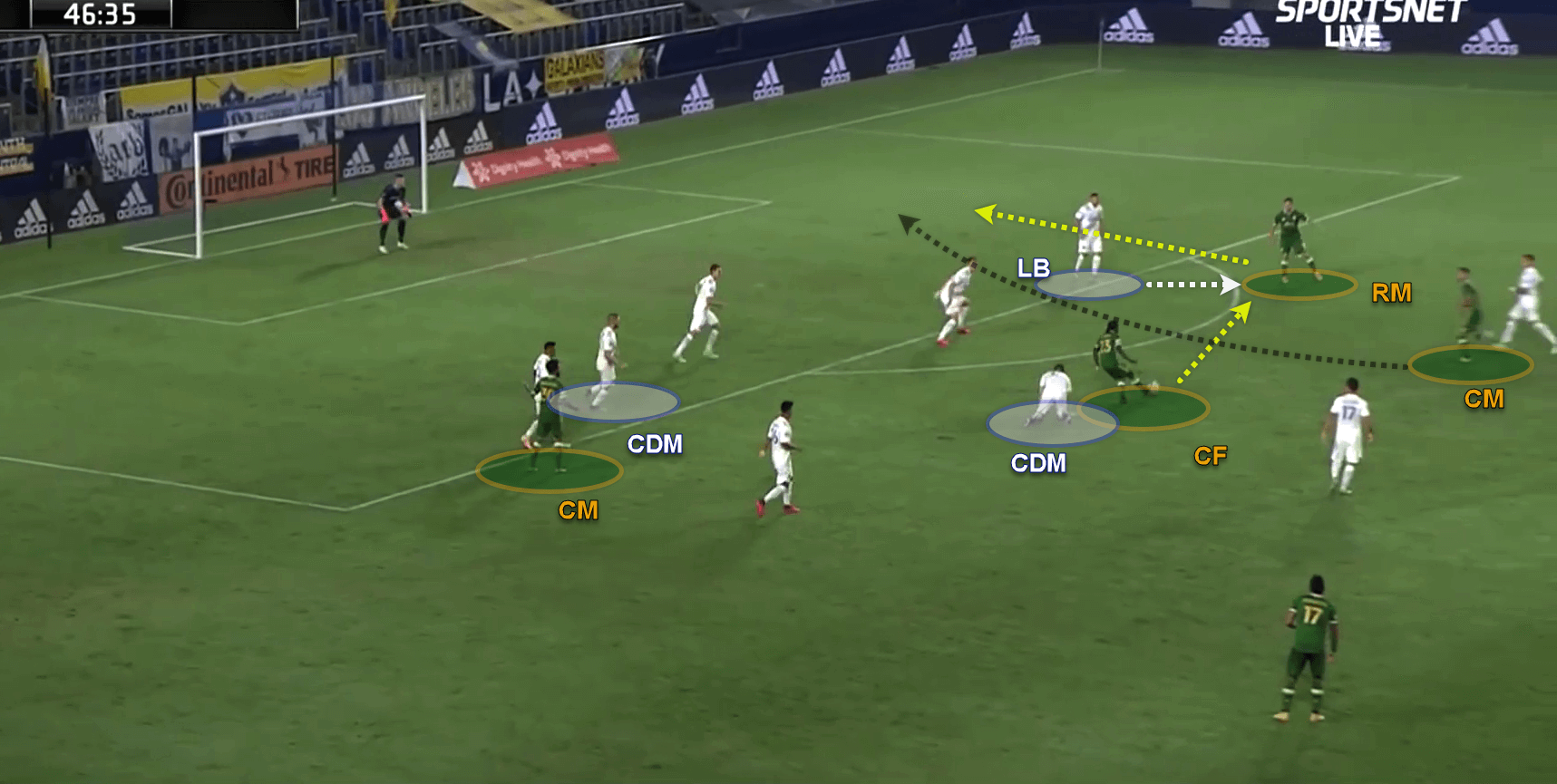
Having turned Klještan with little contest, the next pass can be made to Portland’s ‘RM’.
In anticipation for this pass, the Galaxy left-back Emiliano Insúa can intercept if not successfully defend the Portland player on his first touch. He fails to do so and subsequently offers time and space for the ‘RM’ to make a forward pass to the ‘CM’ running into the box.
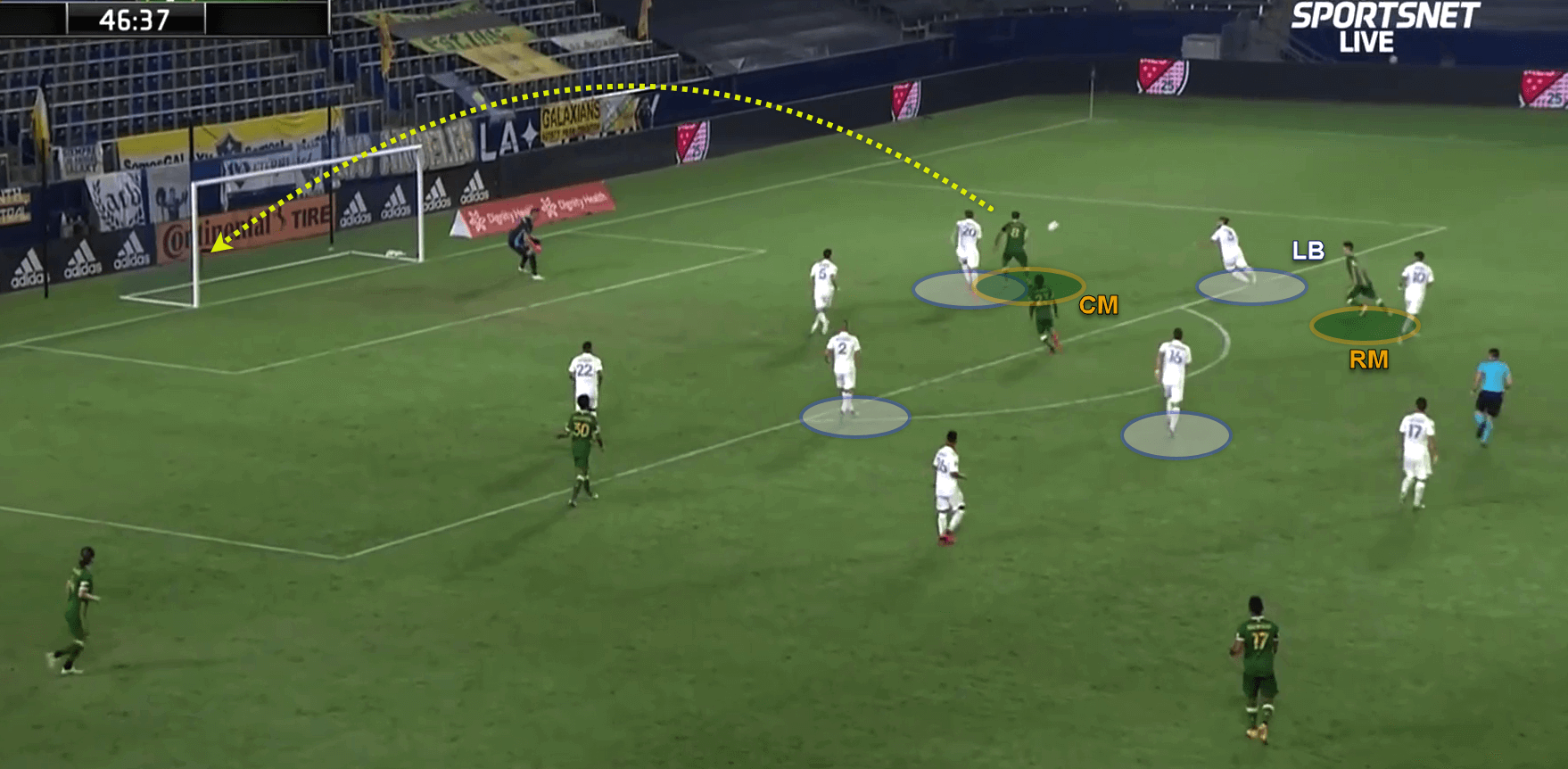
From here, the ‘CM’ is now in a dangerous position as the recovering centre-back for the Galaxy Nick DePuy has to be careful in making contact with the attacker not to give away a penalty, let alone a free shot on goal. The ‘CM’ chips the goalkeeper David Bingham with his second touch and Portland score.
What should have been a routine and straightforward defensive challenge ultimately left us scratching our heads as to why that attack was not defended better. There seem to be many examples of this lately; this must be an area that concerns the Galaxy head coach.
3. Too slow in defensive transitions
One aspect of the modern game that cannot be overlooked is the importance of transitions – the initial moments when possession is lost, and the now defending team are stretched and not organised to defend. The Galaxy rank 19th among 26 teams for most shots against this season, averaging 11 shots against per game.
Watching back game footage since the start of the season, I see a lot of attempts from the opposition come by way of the transition to attack as well as secondary moments from the transition such as organised attacks in Galaxy’s third stemming from the transition.
Let’s take a look at an example of an opponent’s attempt on goal as a result of a quick transition to attack moments after LA Galaxy lose the ball. The following stills are taken from the recent game against Seattle Sounders, a game Seattle won 1-3.
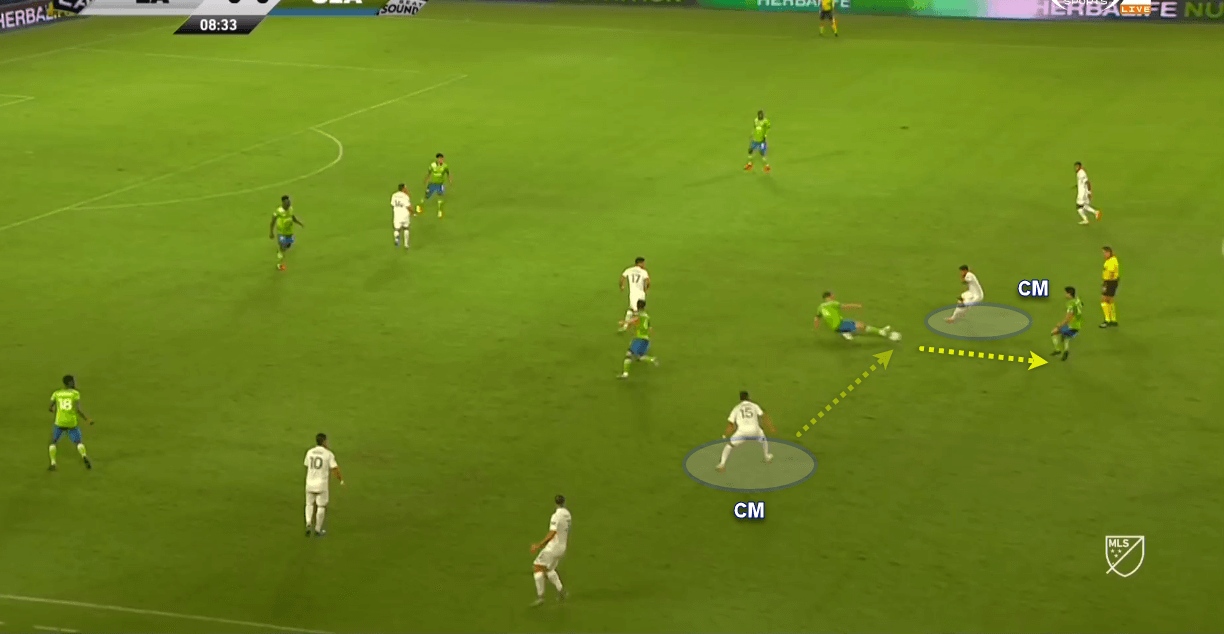
‘CM’ Joe Corona plays a short pass to Johnathan Dos Santos, the pass is intercepted, and Seattle break on the counter. One more pass forward and the ball is at the feet of Seattle’s’ ‘RM’.
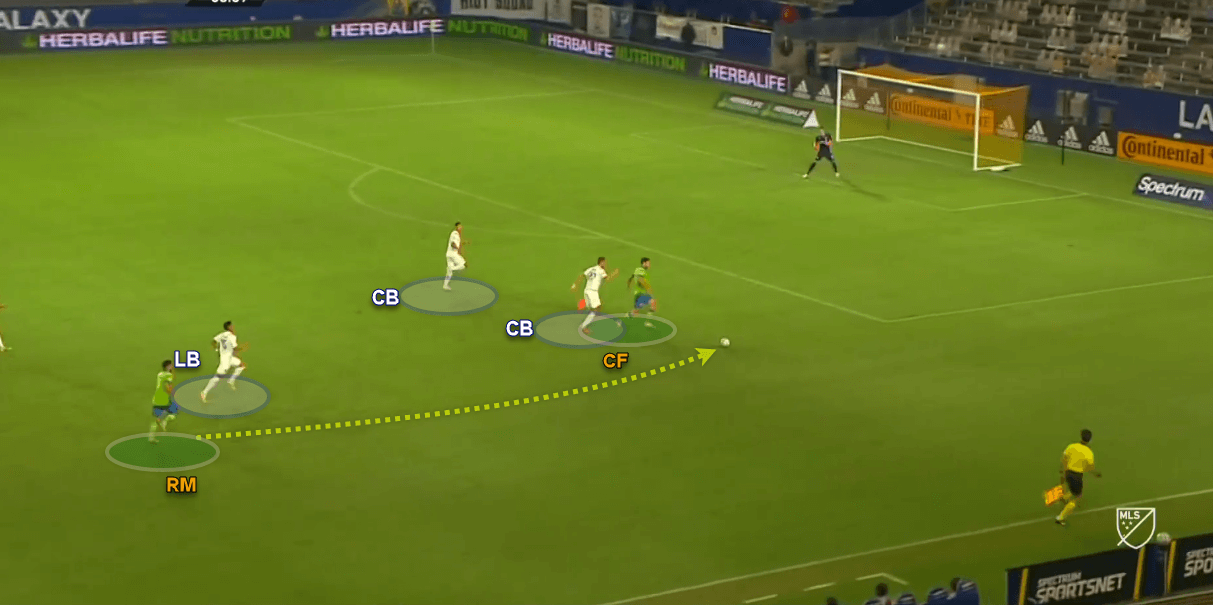
LA Galaxy’s left-back Insúa fails to stop the pass forward from Seattle’s ‘RM’. The ‘CF’ gets in front of the last defender who now has to be careful in making a challenge. The Seattle forward gets the ball into the wide area of the box before looking to feed the run of a supporting attacker.
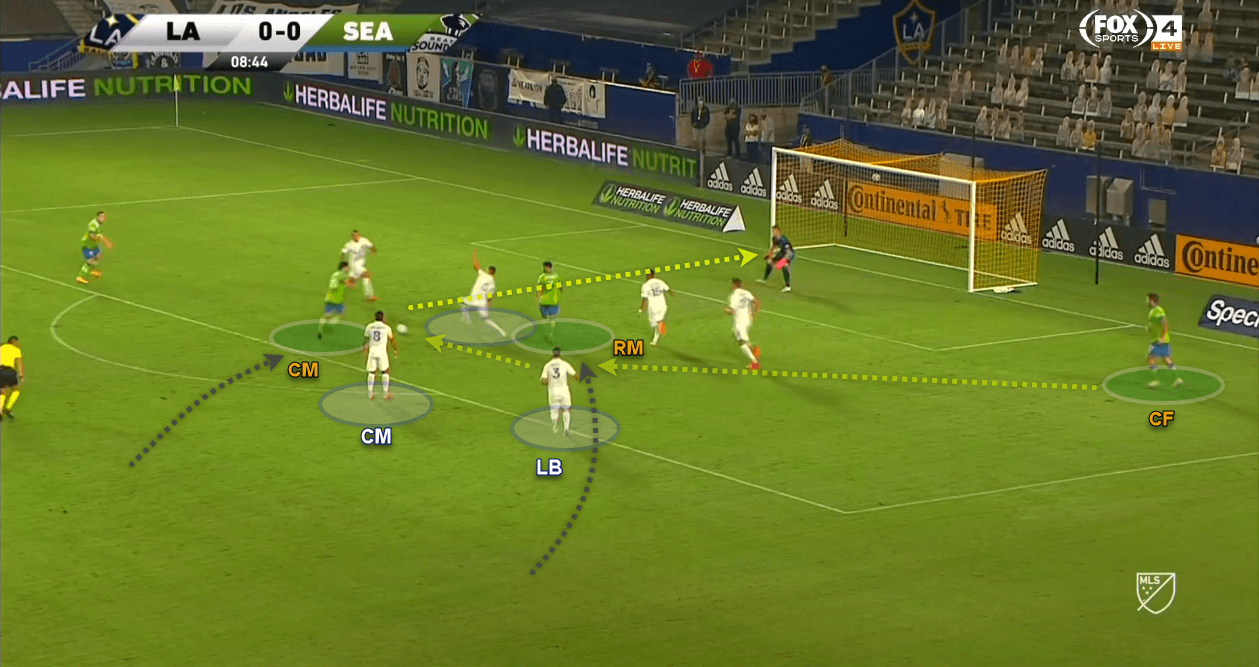
Finding an opportunity to deliver, the Seattle ‘CF’ plays a pass to the ‘RM’ who enters the box unmarked, and subsequently lays up the ‘CM’ for a strike on goal. Notice here both ‘CM’ Dos Santos and ‘LB’ Insúa leave their respective players. Both Seattle players the ‘RM’ and the ‘CM’ for Seattle were behind the Galaxy players before the initial pass from the ‘CF’ was made.
It is here the top sides exercise what is commonly referred to as the dark arts of football. That ability to read the danger the moment the ball is lost and being willing to make a man + ball challenge even if the odds are not in the defender’s favour. Yes, a free-kick might be given, as well as a booking, possibly, yet some would argue it’s better than conceding or suffering the lesser extreme outcome such as corner or throw-in in your third.
If the Galaxy were more willing to commit to these ‘low probability of success’ challenges, they might find themselves higher up the table. Yes, that does sound like an oversimplification, yet when you consider the high volume of shots the Galaxy concede in transition, then it cannot be ignored as a factor for improvement.
4. No clearly defined style of play
Accounting for the high numbers of technical and tactical errors in each game, inconsistent strategies in attack, along with a lack of congruence between the units going forward, LA Galaxy does not show a clear, principled style of play in possession at this time.
Starting with formation, the Galaxy have used the following formations already this season: 4-2-3-1 (40%) 4-1-4-1 (20%) 4-4-2 (20%) and 4-4-1-1 (11%). Rotating formations is perfectly fine within reason; however, too much change and rotation after 17 games mean players cannot perform well consistently, and this tends to detract from individual and team confidence.
After 17 games the Galaxy have an xG of 19.7, ranking 9th lowest in the 12 teams in the West and 17th among all 26 MLS teams. The Galaxy rank 25th from 26 MLS teams for average possession, just 43%. They also rank 23rd from 26 MLS teams for most progressive passes, averaging only 63.3 per game.
When watching the Galaxy from restarts, or in the transition to attack from low, medium or high recoveries, there seems a clear lack of distinction and confidence going forward. This often results in high technical and tactical errors such as players delaying on the ball before passing, a lack of movement to support, and players opting to dribble when it is perhaps best to pass.
When play does reach the final third, it seems the Galaxy drift into wide areas naturally by evading pressure and centrally compact defences. It is from these wide positions by proxy the Galaxy resort to crosses; which we will cover more later.
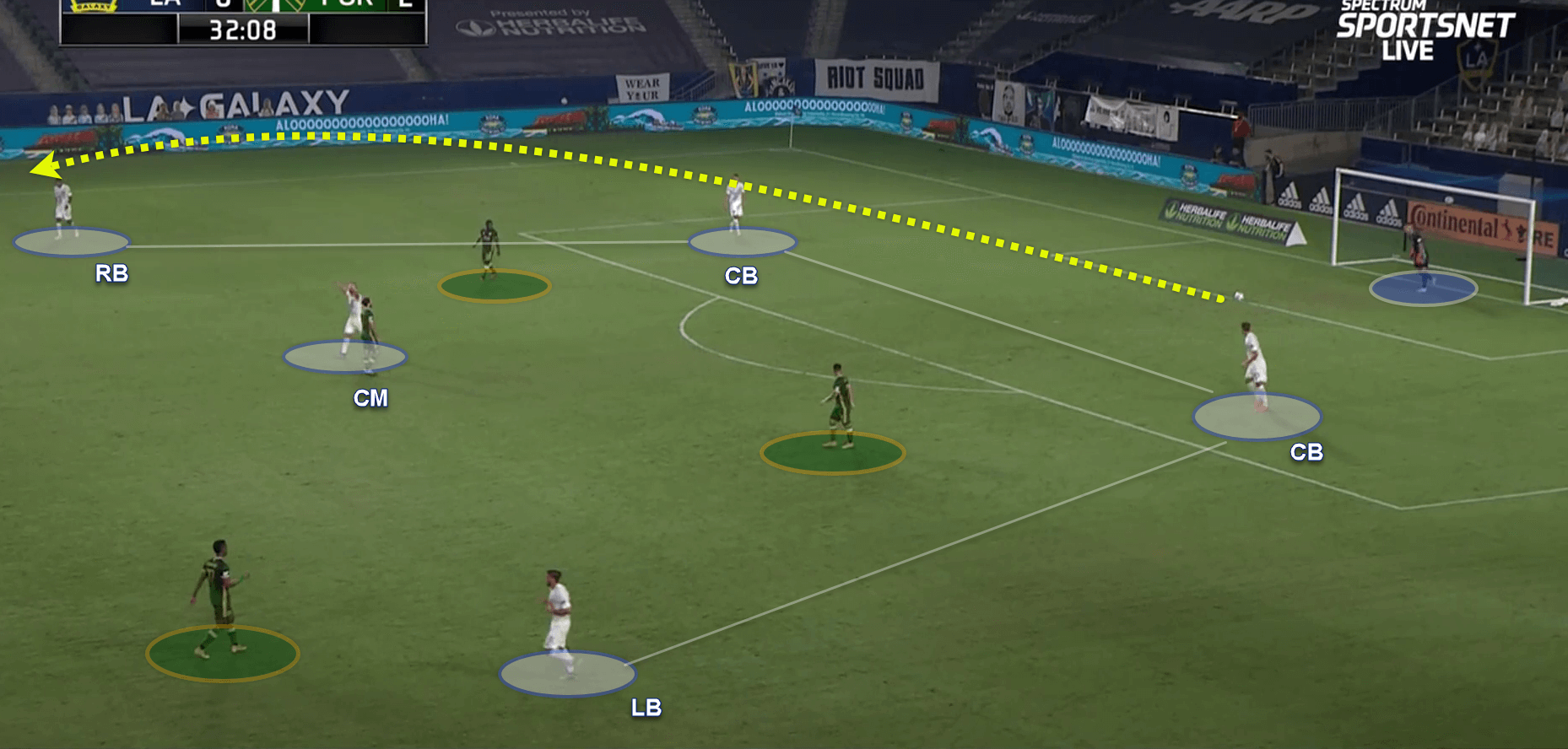
Above, we see an example of mixed messages and how dangerous this can be. LA Galaxy defenders and holding midfielder are positioned to play out from the back. Yet, goalkeeper Bingham decides to go for distance on his goal kick. As a result, Portland wins the aerial contest for the ball and begin to attack in Galaxy’s half. Note the starting positions of the LA Galaxy defenders, the large distances between the midfield and the defence as well as the positions of the two Portland forwards. As a result, LA Galaxy is defending a Portland attack on the edge of their box moments later.
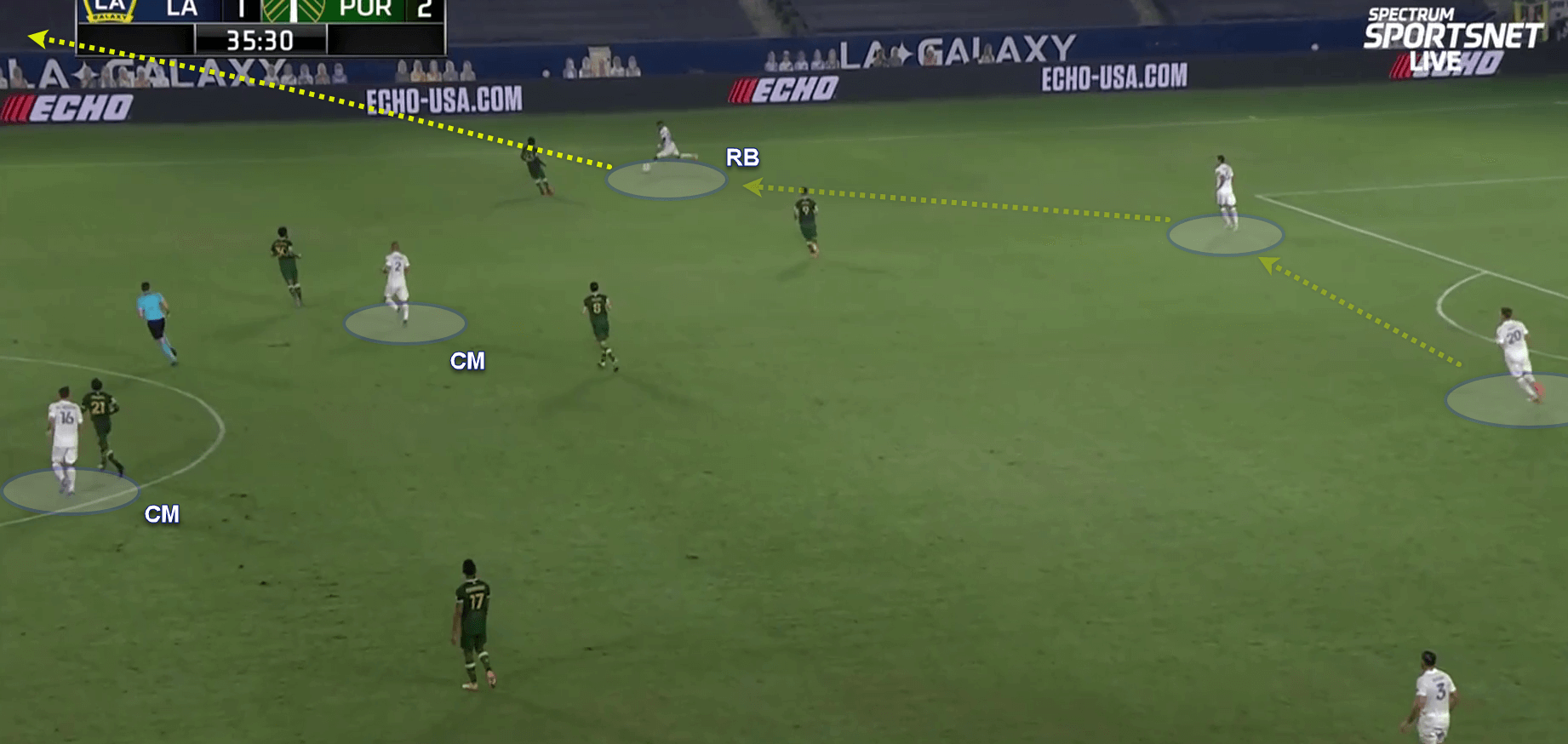
The above and below image complete a snapshot of a moment in which the LA Galaxy aimlessly turn over possession. Above we see the ball reaches the LA Galaxy right-back Araujo who immediately opts for distance as Portland close in on him.
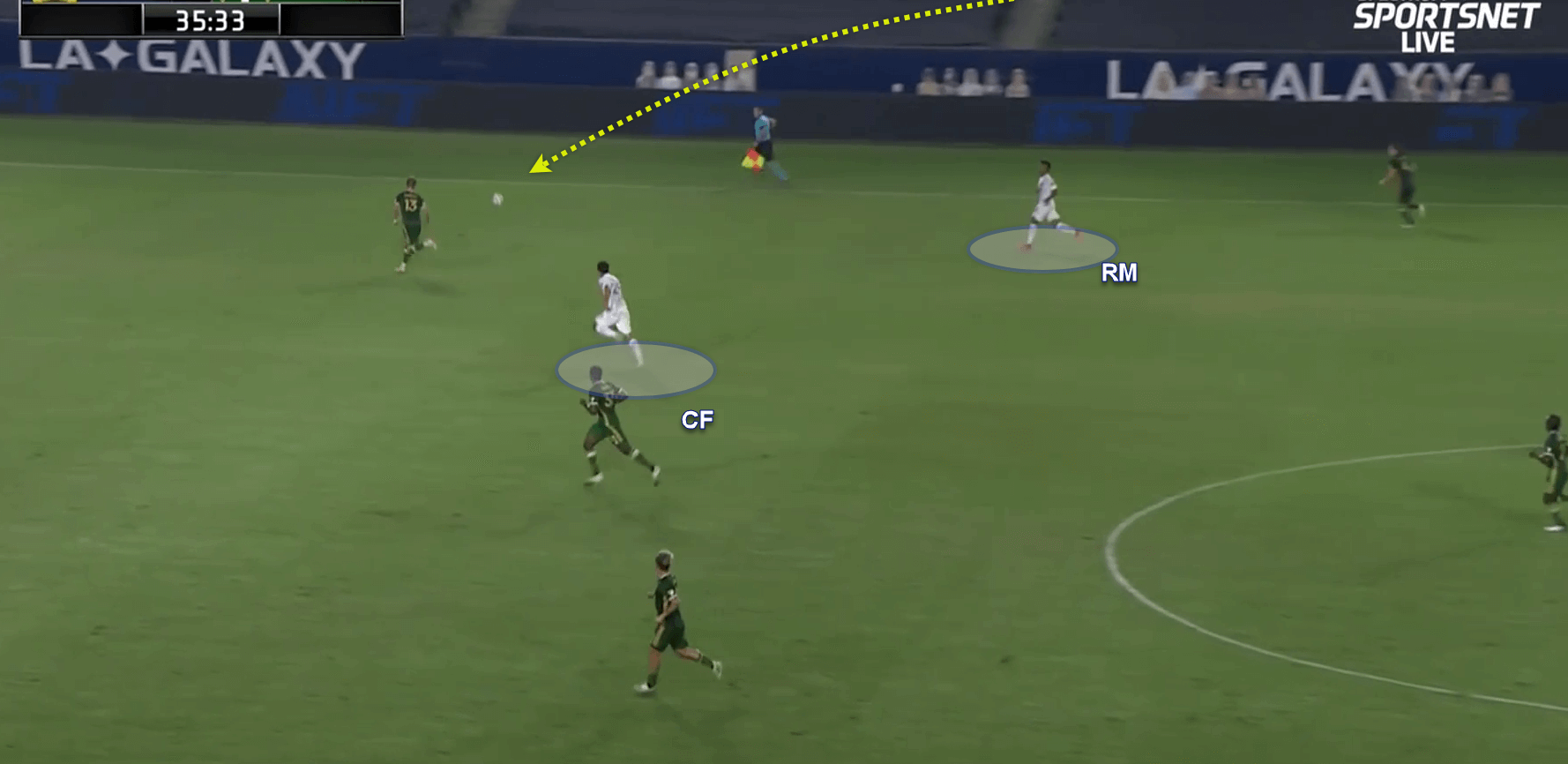
The ball arrives in the same channel of Portland’s third, but with no teammate nearby to receive or even compete for the ball, the right-midfielder Lletget gives chase from a considerable distance but to no avail.
It’s one thing to speak about style yet like many MLS teams, LA Galaxy has looked to their D.P.’s to come up with the answers, but it is just not happening for them so far this season. Former Manchester United ace Javier “Chicharito” Hernández leads the line and he has come under a lot of fire in the media lately due to his lacklustre performances and inability to find the target. The 32-year-old Mexican has registered just one goal this season from 15 games. An underwhelming xG rating of 0.21 per 90 and a shot accuracy of 33% have left many wondering why this seasoned goal-scorer cannot deliver the goods.
Talisman Cristian Pavón is his side’s leading light with seven goals and three assists so far this season. Pavón is a creative winger, a right-footer operating from the left who likes to cut inside and engineer attacks while driving at the box. The 24-year-old Argentinian ranks 21st on the MLS xG leaderboard. Averaging 0.29 expected goals per 90 coupled with a shot accuracy of 38% and a crossing accuracy of 22%, some say he’s good, yet many say he should be doing better.
When times are hard, and a team is not playing well, even the world-class tend not to look all that good. However, should the overall team output and confidence improve, It’s likely we will see better performers in Hernández, Pavón and the currently injured Dos Santos.
5. Crosses are not the answer
At present, LA Galaxy rank as 3rd highest among all 26 MLS sides for most crosses into the box, 16.93 per 90, yet they rank 21st out of 26 for crossing accuracy at just 27%. I would not say the ‘square-peg round-hole’ analogy should be applied here, but one has to wonder why the Galaxy keeps forcing crosses week-in week-out to little or no avail. Of course, yes LA Galaxy have every right to try to get success from crosses in open play, but three significant factors need to be considered and corrected if those stats are to improve.
First, Hernández is 5ft 9″, yes players of this height and even shorter can and have got success from crosses, but it requires opposition defenders of 6ft 2″+ to be stretched and unbalanced from the goalmouth to have a decent chance to score from crosses. Even Yony González who stands at 5ft 11″ has also had a significant issue in front of goal from crosses.
Yet, 6ft 2″ striker Ethan Zubak has scored two goals for the Galaxy this season with only 493 minutes under his belt, and both goals were headed goals from set-pieces. When competing against taller centre-backs, positional superiority relative to the goal matters significantly for the shorter striker.
Second, as we will see from examples below, accuracy married with a well-timed run is required 10 times out of 10. Sometimes the crosses come almost like a flash in the pan or rash decision from a wide player under pressure. The cost is accuracy as we highlighted above and just one in every four crosses find contact with a forward, which is grossly inefficient for a team with this apparent intended style of play.
Third – not competing for second balls. If the Galaxy intends on playing for and getting success with crosses, yet they are aware that three of every four will be defended, one has to wonder why the midfielders who do not enter the box, don’t encroach the box to win second balls. As loose balls from defensive headers will generally fall just outside the box, then there is a chance to get success from second balls.
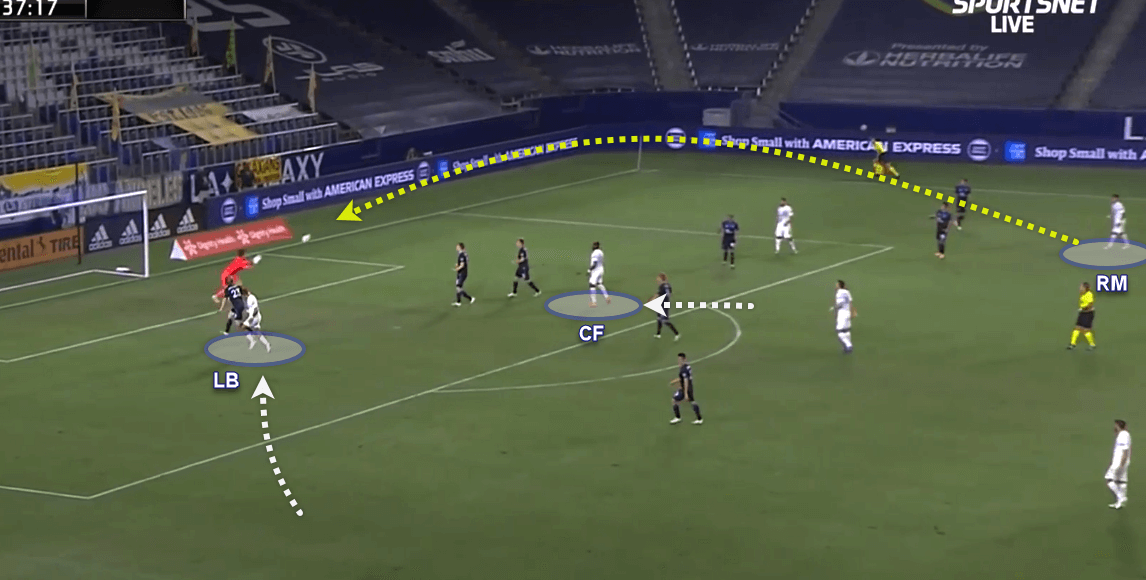
Above we see an example from the recent game against San Jose. Lletget delivers from the right, however before either of the Galaxy’s furthest forward players can attack the ball, the opposition goalkeeper has already claimed without pressure, and San Jose begins the attack.
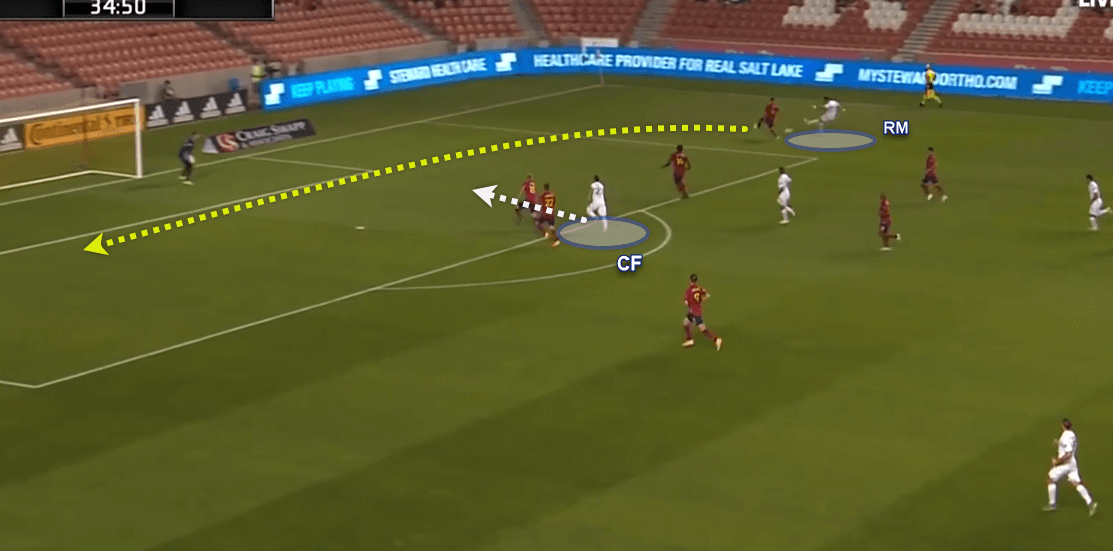
Above, we see another example of a mistimed cross against Real Salt Lake earlier this season. Without looking, Lletget delivers before ‘CF’ Hernández has even stepped foot in the box. The ball runs out the opposite side without contact by either an attacker or defender.
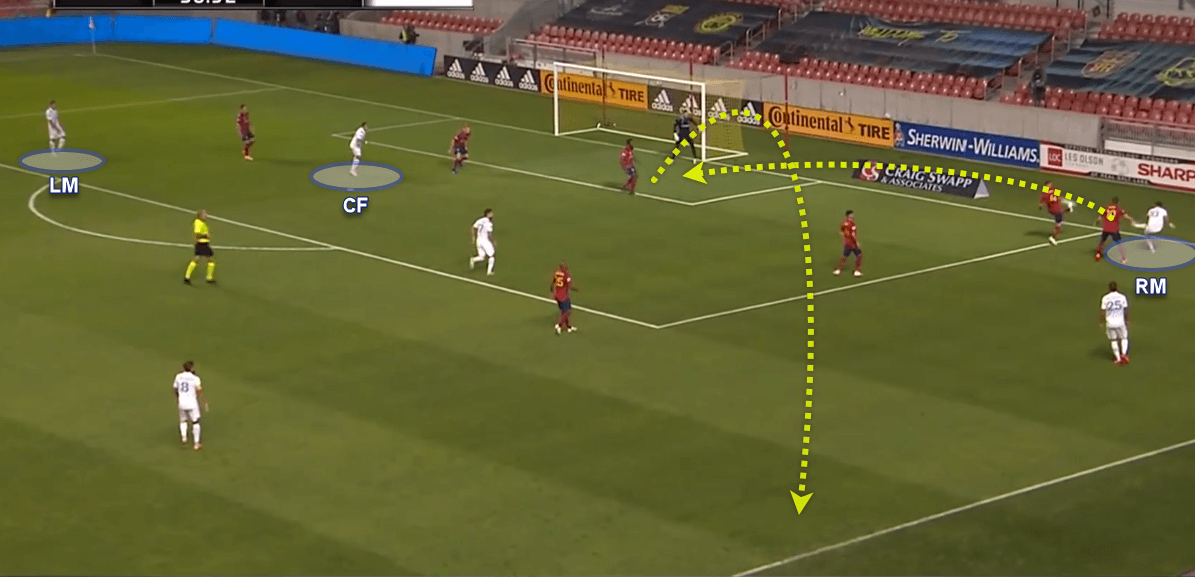
Finally, we see above, in the same game against RSL, Lletget delivers a first-time cross but it was hip-height at best and never made it to the goalmouth before being cleared. Observing the positions of all three of the Galaxy’s players in the box, a high cross centrally or to the back post would have a better probability of finding the net.
Final thoughts
After a thorough examination of LA Galaxy’s first 17 games, I felt these five aspects were a true line through all their performances. Poor defending can erode the confidence of the team going forward, always with the caution and fear that by committing bodies forward and not scoring can cause you to concede as a result of being wide open. When this plays on the players’ minds, individual and overall team confidence begins to wane.
The Galaxy needs to stop the bleeding – a better defensive solidity to shut out teams and to still be in games in the latter stages will give these players more confidence to turn ties on their head and give them a better chance to come away with points.
I look forward to seeing how LA Galaxy performs in these coming weeks, with the playoffs fast approaching, this should give the players and staff the motivation they need to turn their season around and end on a high. To track the progress of this side, be sure to check back in with us here at Total Football Analysis.

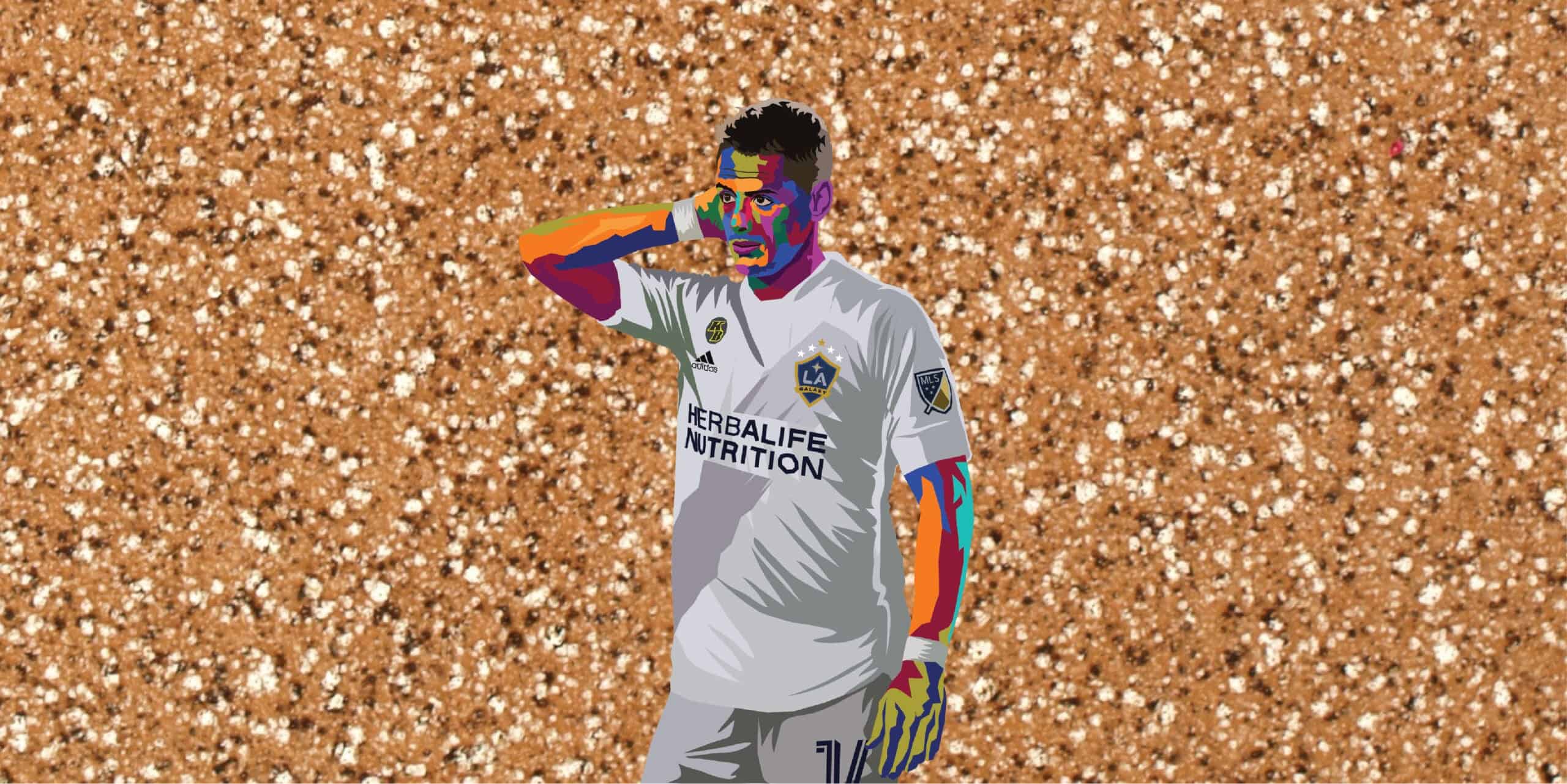



Comments